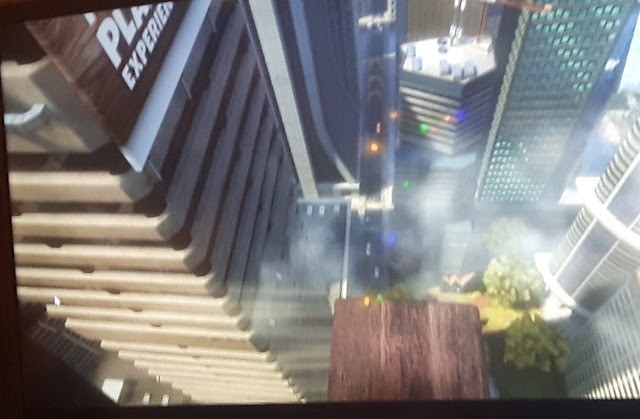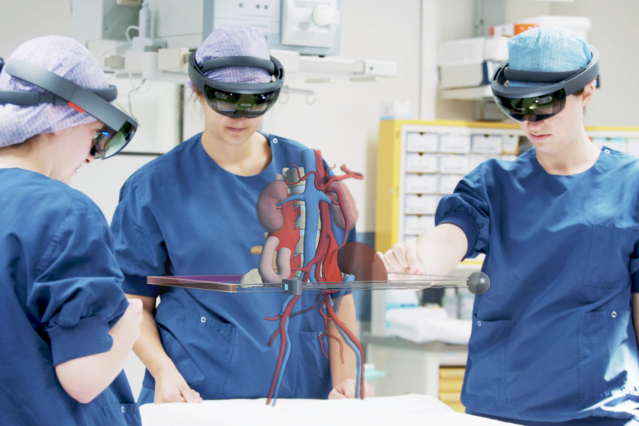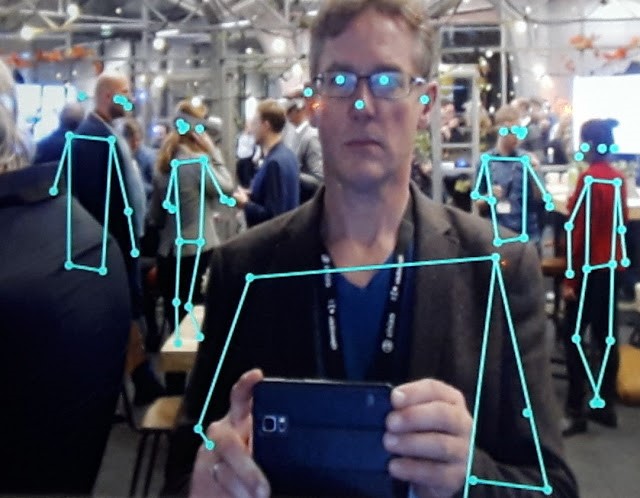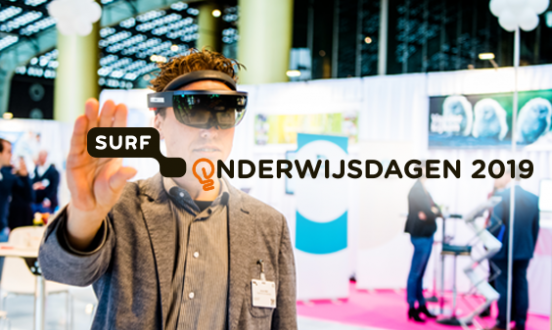I put on the VR glasses with 360 wrap around audio and stepped into the lift. Through the crack in the doors I could see my progress to the 50th floor. The doors opened. In front of me was a narrow plank. I walked towards the abyss

| Walking the plank 50 stories up. Would you jump? |

Let’s face it … there was absolutely no way in Hell I would ‘jump’. Even knowing in reality it was only 20 cm to the floor below. My rational mind was trying to convince me it was o.k., while millions of years of evolution were telling me not to. The virtual reality was convincing enough to make me tremble so I cautiously retreated backwards into the lift, closed the doors and returned safely to the ‘ground’ floor.
On Tuesday 5th November I attended the SURF Education Days in Den Bosch arranged by SURF. See previous blogs here 2018, 2017 & 2016. Since my focus is on teaching with, and through, video I focused on trying out video technologies.
Eye contact for teaching; VR vs AR
The Centre4Innovation had set up the VR session and I was fully immersed in that world. While I was (not) jumping off the building my eyes were completely covered, and I lost all sense of my surroundings.
I also tried the HoloLens glasses, transparent wrap-around googles which ‘Augment’ Reality. Looking through the glasses at the conference hall, I saw a 3d holographic rib cage floating in the space in front of me. It was in a fixed position and I could walk around it and view it from all sides. Also, I could use a listening device (a sort of stethoscope) to listen to the lungs. Were they healthy or unhealthy? Another AR application they have uses sensors attached to your ankle to move and ‘control’ the hologram ankle in mid-air in front of you.
While I was viewing the 3d lungs, I could also see several of the other conference participants walking around, viewing the lungs in mid-air. And I could see their eyes through their glasses and have interaction with them. The man demonstrating the AR was also busy pointing things out on the 3d lungs and explaining things. I could see him, and his eyes too. He could check with me whether I was understanding him. This feels much more like real teaching and I could imagine myself using AR and discussing points with a group of students. The technology is unencumbered, intuitive and feels natural.
This is all very different in VR. When I was about to jump, I could not see anyone around me. I felt removed from the ‘real’ world. Although I’ve heard of some VR scenarios where the teacher can join the VR world as an avatar, I’m not convinced this would come close to the real feel I experienced in the AR context.
Maybe you’ve had experience of this or have some ideas on it? If so, I’d like to hear from you.
Either way, these formats have huge potential for walking through complicated 3d spaces or following class around an AR object.
Robert Wendrich of the University of Twente has developed a wonderfully intuitive and simple creative device using video. An overhead camera looks down on a sheet of white paper on a table. The screen in front of you displays the workspace. With transparent tweezers you hold an object under the camera (on the paper or somewhere in the space between the camera and table). Using your foot, you press a pedal and ‘take a picture’ of the object. This frees up both your hands. Your active stance is more like being at a potter’s wheel than working behind a computer.
The object is captured and frozen on the screen. The really cool thing is that you can then take multiple pictures of the same, or different, objects. They accumulate into a collage. Building up like a stop-motion movie. Very simple to use, quick and with a learning curve of zero. I tried it out and could not stop. The girl in the picture below was fully engaged for 10 minutes with no instruction and fully creative. She is carefully colouring in the sun in the top left-hand corner. What I really liked was the active stance of those who were creating. Standing, moving, twisting. This is the complete opposite of the consumption mode experienced when we are viewing video in of a more passive kind.
I can imagine many uses for this approach in education. Especially in creative and design courses where three dimensional spaces and objects can be translated into two dimensional images or stop-motion movies. Inspiring!

Facial Recognition
At another stand, AI confronted me on the screen with my own scanned and data-pointed image. I was digitalized and reduced to a series of blue dots and lines. It was frightening to see how effortlessly the system captured and presented the data. And the many people in the crowd behind me were also clearly represented. This type of video technology is used to teach athletes or professionals about how they move through 3d spaces. And for tracking citizens!

There was plenty of video related technology to inspire my further explorations into video teaching.

Author
Zac Woolfitt
Inholland University of Applied Sciences, The Netherlands
Read more from Zac’s blog.














